Spatial–Temporal Variation Characteristics and Driving Factors of Net Primary Production in the Yellow River Basin over Multiple Time Scales
Abstract
:1. Introduction
2. Materials and Methods
2.1. Study Area
2.2. Data Source and Preprocessing
2.2.1. Net Primary Productivity Data
2.2.2. Digital Elevation Model
2.2.3. Meteorological Data
2.2.4. Human Activity Factors
2.2.5. Land-Use Data
2.3. Methods of Analysis
2.3.1. Theil–Sen Median Trend Analysis and Mann–Kendall Test
2.3.2. Ensemble Empirical Mode Decomposition (EEMD) Method
2.3.3. Correlation Analysis Method
2.3.4. Multivariate Regression Analysis (MLR)
3. Results
3.1. Data Validation
3.2. Spatiotemporal Variation of NPP in the YRB
3.2.1. Temporal Variation of NPP
3.2.2. Spatial Pattens of NPP
3.2.3. Linear and Nonlinear Trends for NPP
3.3. Multi-Timescale Analyses for Vegetation NPP
3.4. The Temporal Relationships between Vegetation NPP and Various Climatic Factors
3.4.1. Multiple Time Scale Analysis for Meteorological Factors
3.4.2. Possible Relationships between NPP and Climate Factors at Different Time Scales
3.5. The Relative Contributions of Climate Changes and Human Activities to Vegetation NPP across Multiple Time Scales
4. Discussion
4.1. Nonlinear Trends of Vegetation NPP Dynamics
4.2. Effects of Climate Change of Vegetation NPP across Multi-Time Scales
4.3. The Effects of Human Activities on Vegetation NPP across Multi-Time Scales
4.4. Limitation and Future Work
5. Conclusions
Supplementary Materials
Author Contributions
Funding
Data Availability Statement
Acknowledgments
Conflicts of Interest
References
- Legg, S. IPCC, 2021: Climate change 2021-the physical science basis. Interaction 2021, 49, 44–45. [Google Scholar]
- Chang, J.; Liu, Q.; Wang, S.; Huang, C. Vegetation Dynamics and Their Influencing Factors in China from 1998 to 2019. Remote Sens. 2022, 14, 3390. [Google Scholar] [CrossRef]
- Jian, S.Q.; Zhang, Q.K.; Wang, H.L. Spatial-Temporal Trends in and Attribution Analysis of Vegetation Change in the Yellow River Basin, China. Remote Sens. 2022, 14, 4607. [Google Scholar] [CrossRef]
- Zhou, X.; Peng, B.; Zhou, Y.; Yu, F.; Wang, X.-C. Quantifying the Influence of Climate Change and Anthropogenic Activities on the Net Primary Productivity of China’s Grasslands. Remote Sens. 2022, 14, 4844. [Google Scholar] [CrossRef]
- Liu, H.; Jia, J.; Lin, Z.; Wang, Z.; Gong, H. Relationship between net primary production and climate change in different vegetation zones based on EEMD detrending—A case study of Northwest China. Ecol. Indic. 2021, 122, 107276. [Google Scholar] [CrossRef]
- Zhang, F.; Hu, X.S.; Zhang, J.; Li, C.Y.; Zhang, Y.P.; Li, X.L. Change in Alpine Grassland NPP in Response to Climate Variation and Human Activities in the Yellow River Source Zone from 2000 to 2020. Sustainability 2022, 14, 8790. [Google Scholar] [CrossRef]
- Field, C.B.; Behrenfeld, M.J.; Randerson, J.T.; Falkowski, P. Primary production of the biosphere: Integrating terrestrial and oceanic components. Science 1998, 281, 237–240. [Google Scholar] [CrossRef]
- Xue, P.; Liu, H.; Zhang, M.; Gong, H.; Cao, L. Nonlinear Characteristics of NPP Based on Ensemble Empirical Mode Decomposition from 1982 to 2015-A Case Study of Six Coastal Provinces in Southeast China. Remote Sens. 2022, 14, 15. [Google Scholar] [CrossRef]
- Gong, H.B.; Cao, L.; Duan, Y.F.; Jiao, F.S.; Xu, X.J.; Zhang, M.Y.; Wang, K.L.; Liu, H.Y. Multiple effects of climate changes and human activities on NPP increase in the Three-north Shelter Forest Program area. For. Ecol. Manag. 2023, 529, 120732. [Google Scholar] [CrossRef]
- Chen, T.; Tang, G.; Yuan, Y.; Guo, H.; Xu, Z.; Jiang, G.; Chen, X. Unraveling the relative impacts of climate change and human activities on grassland productivity in Central Asia over last three decades. Sci Total Env. 2020, 743, 140649. [Google Scholar] [CrossRef]
- Wang, B.; Sun, R.; Deng, Y.; Zhu, H.; Hou, M. The Variability of Net Primary Productivity and Its Response to Climatic Changes Based on the Methods of Spatiotemporal Decomposition in the Yellow River Basin, China. Pol. J. Environ. Stud. 2022, 31, 4229–4312. [Google Scholar] [CrossRef] [PubMed]
- Liu, H.; Zhang, M.; Lin, Z. Relative importance of climate changes at different time scales on net primary productivity-a case study of the Karst area of northwest Guangxi, China. Env. Monit Assess 2017, 189, 539. [Google Scholar] [CrossRef]
- Liang, W.; Yang, Y.T.; Fan, D.M.; Guan, H.D.; Zhang, T.; Long, D.; Zhou, Y.; Bai, D. Analysis of spatial and temporal patterns of net primary production and their climate controls in China from 1982 to 2010. Agric. For. Meteorol. 2015, 204, 22–36. [Google Scholar] [CrossRef]
- Hawinkel, P.; Swinnen, E.; Lhermitte, S.; Verbist, B.; Van Orshoven, J.; Muys, B. A time series processing tool to extract climate-driven interannual vegetation dynamics using Ensemble Empirical Mode Decomposition (EEMD). Remote Sens. Environ. 2015, 169, 375–389. [Google Scholar] [CrossRef]
- Ghorbanian, A.; Mohammadzadeh, A.; Jamali, S. Linear and Non-Linear Vegetation Trend Analysis throughout Iran Using Two Decades of MODIS NDVI Imagery. Remote Sens. 2022, 14, 3683. [Google Scholar] [CrossRef]
- Cao, R.; Hu, Z.; Jiang, Z.; Yang, Y.; Zhao, W.; Wu, G.; Feng, X.; Chen, R.; Hao, G. Shifts in ecosystem water use efficiency on china’s loess plateau caused by the interaction of climatic and biotic factors over 1985–2015. Agric. For. Meteorol. 2020, 291, 108100. [Google Scholar] [CrossRef]
- Cui, J.; Wang, Y.; Zhou, T.; Jiang, L.; Qi, Q. Temperature Mediates the Dynamic of MODIS NPP in Alpine Grassland on the Tibetan Plateau, 2001–2019. Remote Sens. 2022, 14, 2401. [Google Scholar] [CrossRef]
- Ma, B.; Jing, J.; Liu, B.; Xu, Y.; Dou, S.; He, H. Quantitative assessment of the relative contributions of climate change and human activities to NPP changes in the Southwest Karst area of China. Environ. Sci. Pollut. Res. 2022, 29, 80597–80611. [Google Scholar] [CrossRef]
- Song, Y.; Liang, T.; Zhang, L.; Hao, C.; Wang, H. Spatio-Temporal Changes and Contribution of Human and Meteorological Factors to Grassland Net Primary Productivity in the Three-Rivers Headwater Region from 2000 to 2019. Atmosphere 2023, 14, 278. [Google Scholar] [CrossRef]
- Chen, B.; Zhang, X.; Tao, J.; Wu, J.; Wang, J.; Shi, P.; Zhang, Y.; Yu, C. The impact of climate change and anthropogenic activities on alpine grassland over the Qinghai-Tibet Plateau. Agric. For. Meteorol. 2014, 189–190, 11–18. [Google Scholar] [CrossRef]
- Shi, S.Y.; Yu, J.J.; Wang, F.; Wang, P.; Zhang, Y.C.; Jin, K. Quantitative contributions of climate change and human activities to vegetation changes over multiple time scales on the Loess Plateau. Sci. Total Environ. 2021, 755, 142419. [Google Scholar] [CrossRef]
- Zhao, L.; Liu, Z.; Hu, Y.; Zhou, W.; Peng, Y.; Ma, T.; Liu, L.; Li, S.; Wang, L.; Mao, X. Evaluation of Reasonable Stocking Rate Based on the Relative Contribution of Climate Change and Grazing Activities to the Productivity of Alpine Grasslands in Qinghai Province. Remote Sens. 2022, 14, 1455. [Google Scholar] [CrossRef]
- Xu, X.J.; Jiao, F.S.; Liu, H.Y.; Gong, H.B.; Zou, C.X.; Lin, N.F.; Xue, P.; Zhang, M.Y.; Wang, K.L. Persistence of increasing vegetation gross primary production under the interactions of climate change and land use changes in Northwest China. Sci. Total Environ. 2022, 834, 155086. [Google Scholar] [CrossRef] [PubMed]
- Xuan, W.; Rao, L. Spatiotemporal dynamics of net primary productivity and its influencing factors in the middle reaches of the Yellow River from 2000 to 2020. Front. Plant Sci. 2023, 14, 1043807. [Google Scholar] [CrossRef] [PubMed]
- Xu, X.J.; Liu, H.Y.; Jiao, F.S.; Gong, H.B.; Lin, Z.S. Nonlinear relationship of greening and shifts from greening to browning in vegetation with nature and human factors along the Silk Road Economic Belt. Sci. Total Environ. 2021, 766, 142553. [Google Scholar] [CrossRef] [PubMed]
- Ji, Y.; Zhou, G.; Wang, S.; Wang, L. Prominent vegetation greening and its correlation with climatic variables in northern China. Environ. Monit. Assess. 2020, 192, 636. [Google Scholar] [CrossRef] [PubMed]
- Liu, H.Y.; Zhang, M.Y.; Lin, Z.S.; Xu, X.J. Spatial heterogeneity of the relationship between vegetation dynamics and climate change and their driving forces at multiple time scales in Southwest China. Agric. For. Meteorol. 2018, 256, 10–21. [Google Scholar] [CrossRef]
- Zhang, W.; Wang, L.C.; Xiang, F.F.; Qin, W.M.; Jiang, W.X. Vegetation dynamics and the relations with climate change at multiple time scales in the Yangtze River and Yellow River Basin, China. Ecol. Indic. 2020, 110, 105892. [Google Scholar] [CrossRef]
- Tian, F.; Liu, L.Z.; Yang, J.H.; Wu, J.J. Vegetation greening in more than 94% of the Yellow River Basin (YRB) region in China during the 21st century caused jointly by warming and anthropogenic activities. Ecol. Indic. 2021, 125, 107479. [Google Scholar] [CrossRef]
- Hong, S.; Zhang, Y.; Yao, Y.; Meng, F.; Zhao, Q.; Zhang, Y. Contrasting temperature effects on the velocity of early- versus late-stage vegetation green-up in the Northern Hemisphere. Glob. Chang. Biol. 2022, 28, 6961–6972. [Google Scholar] [CrossRef]
- Hu, Y.G.; Li, H.; Wu, D.; Chen, W.; Zhao, X.; Hou, M.L.; Li, A.J.; Zhu, Y.J. LAI-indicated vegetation dynamic in ecologically fragile region: A case study in the Three-North Shelter Forest program region of China. Ecol. Indic. 2021, 120, 106932. [Google Scholar] [CrossRef]
- Wu, Z.; Huang, N.E. Ensemble empirical mode decomposition: A noise-assisted data analysis method. Adv. Adapt. Data Anal. 2009, 1, 1–41. [Google Scholar] [CrossRef]
- Kong, D.; Zhang, Q.; Singh, V.P.; Shi, P. Seasonal vegetation response to climate change in the Northern Hemisphere (1982–2013). Glob. Planet. Chang. 2017, 148, 1–8. [Google Scholar] [CrossRef]
- Xue, Y.Y.; Zhang, B.Q.; He, C.S.; Shao, R. Detecting Vegetation Variations and Main Drivers over the Agropastoral Ecotone of Northern China through the Ensemble Empirical Mode Decomposition Method. Remote Sens. 2019, 11, 1860. [Google Scholar] [CrossRef]
- Feng, Y.; Zhu, J.; Zhao, X.; Tang, Z.; Zhu, J.; Fang, J. Changes in the trends of vegetation net primary productivity in China between 1982 and 2015. Environ. Res. Lett. 2019, 14, 124009. [Google Scholar] [CrossRef]
- Wei, F.L.; Wang, S.; Fu, B.J.; Pan, N.Q.; Feng, X.M.; Zhao, W.W.; Wang, C. Vegetation dynamic trends and the main drivers detected using the ensemble empirical mode decomposition method in East Africa. Land Degrad. Dev. 2018, 29, 2542–2553. [Google Scholar] [CrossRef]
- Yin, Y.X.; Xu, C.Y.; Chen, H.S.; Li, L.; Xu, H.L.; Li, H.; Jain, S.K. Trend and concentration characteristics of precipitation and related climatic teleconnections from 1982 to 2010 in the Beas River basin, India. Glob. Planet. Chang. 2016, 145, 116–129. [Google Scholar] [CrossRef]
- Ren, Z.G.; Tian, Z.H.; Wei, H.T.; Liu, Y.; Yu, Y.P. Spatiotemporal evolution and driving mechanisms of vegetation in the Yellow River Basin, China during 2000–2020. Ecol. Indic. 2022, 138, 108832. [Google Scholar] [CrossRef]
- Guo, X.; Tong, S.; Ren, J.; Ying, H.; Bao, Y. Dynamics of Vegetation Net Primary Productivity and Its Response to Drought in the Mongolian Plateau. Atmosphere 2021, 12, 1587. [Google Scholar] [CrossRef]
- Xiao, F.; Liu, Q.; Xu, Y. Estimation of Terrestrial Net Primary Productivity in the Yellow River Basin of China Using Light Use Efficiency Model. Sustainability 2022, 14, 7399. [Google Scholar] [CrossRef]
- Tian, H.W.; Ji, X.J.; Zhang, F.M. Spatiotemporal Variations of Vegetation Net Primary Productivity and Its Response to Meteorological Factors across the Yellow River Basin During the Period 1981–2020. Front. Environ. Sci. 2022, 10, 949564. [Google Scholar] [CrossRef]
- Chen, S.; Zhang, Q.; Chen, Y.; Zhou, H.; Xiang, Y.; Liu, Z.; Hou, Y. Vegetation Change and Eco-Environmental Quality Evaluation in the Loess Plateau of China from 2000 to 2020. Remote Sens. 2023, 15, 424. [Google Scholar] [CrossRef]
- Zhang, Y.; Hu, Q.; Zou, F. Spatio-Temporal Changes of Vegetation Net Primary Productivity and Its Driving Factors on the Qinghai-Tibetan Plateau from 2001 to 2017. Remote Sens. 2021, 13, 1566. [Google Scholar] [CrossRef]
- Turner, D.P.; Ritts, W.D.; Cohen, W.B.; Gower, S.T.; Running, S.W.; Zhao, M.S.; Costa, M.H.; Kirschbaum, A.A.; Ham, J.M.; Saleska, S.R.; et al. Evaluation of MODIS NPP and GPP products across multiple biomes. Remote Sens. Environ. 2006, 102, 282–292. [Google Scholar] [CrossRef]
- Zhao, M.S.; Running, S.W. Drought-Induced Reduction in Global Terrestrial Net Primary Production from 2000 through 2009. Science 2010, 329, 940–943. [Google Scholar] [CrossRef] [PubMed]
- Jiang, T.; Wang, X.L.; Afzal, M.M.; Sun, L.; Luo, Y. Vegetation Productivity and Precipitation Use Efficiency across the Yellow River Basin: Spatial Patterns and Controls. Remote Sens. 2022, 14, 5074. [Google Scholar] [CrossRef]
- Yang, H.F.; Zhong, X.N.; Deng, S.Q.; Xu, H. Assessment of the impact of LUCC on NPP and its influencing factors in the Yangtze River basin, China. Catena 2021, 206, 105542. [Google Scholar] [CrossRef]
- Sen, P.K. Estimates of the regression coefficient based on Kendall’s tau. J. Am. Stat. Assoc. 1968, 63, 1379–1389. [Google Scholar] [CrossRef]
- Mann, H.B. Nonparametric tests against trend. Econom. J. Econom. Soc. 1945, 13, 245–259. [Google Scholar] [CrossRef]
- Kendall, M. Rank Correlation Methods. Charles Grifin, London. Ref. Sci. Res. Publishing. Retrieved March 1975, 31, 2020. [Google Scholar]
- Yan, X.; Li, J.; Shao, Y.; Hu, Z.; Yang, Z.; Yin, S.; Cui, I. Driving forces of grassland vegetation changes in Chen Barag Banner, Inner Mongolia. Gisci. Remote Sens. 2020, 57, 753–769. [Google Scholar] [CrossRef]
- Sun, Z.; Mao, Z.; Yang, L.; Liu, Z.; Han, J.; Wanag, H.; He, W. Impacts of climate change and afforestation on vegetation dynamic in the Mu Us Desert, China. Ecol. Indic. 2021, 129, 108020. [Google Scholar] [CrossRef]
- Jiang, Z.Y.; Yang, Z.G.; Zhang, S.Y.; Liao, C.M.; Hu, Z.M.; Cao, R.C.; Wu, H.W. Revealing the spatio-temporal variability of evapotranspiration and its components based on an improved Shuttleworth-Wallace model in the Yellow River Basin. J. Environ. Manag. 2020, 262, 110310. [Google Scholar] [CrossRef]
- Shi, S.Y.; Wang, P.; Yu, J.J. Vegetation greening and climate change promote an increase in evapotranspiration across Siberia. J. Hydrol. 2022, 610, 127965. [Google Scholar] [CrossRef]
- Wang, Z.; Dong, C.; Dai, L.; Wang, R.; Liang, Q.; He, L.; Wei, D. Spatiotemporal evolution and attribution analysis of grassland NPP in the Yellow River source region, China. Ecol. Inform. 2023, 76, 102135. [Google Scholar] [CrossRef]
- Zhao, F.; Wu, Y.; Yao, Y.; Sun, K.; Zhang, X.; Winowiecki, L.; Sun, Y. Predicting the climate change impacts on water-carbon coupling cycles for a loess hilly-gully watershed. J. Hydrol. 2020, 581, 124388. [Google Scholar] [CrossRef]
- Rong, T.; Long, L.H. Quantitative Assessment of NPP Changes in the Yellow River Source Area from 2001 to 2017. In Proceedings of the IOP Conference Series: Earth and Environmental Science; IOP Publishing: Bristol, UK, 2021; p. 012002. [Google Scholar]
- Pengfei, C. Monthly NPP dataset covering China′ s terrestrial ecosystems at North of 18 N (1985—2015). J. Glob. Chang. Data Discov. 2019, 3, 34–41. [Google Scholar]
- Zheng, Y.; Dong, L.; Xia, Q.; Liang, C.Z.; Wang, L.X.; Shao, Y.P. Effects of revegetation on climate in the Mu Us Sandy Land of China. Sci. Total Environ. 2020, 739, 139958. [Google Scholar] [CrossRef]
- Li, J.; Wang, Z.L.; Lai, C.G.; Wu, X.Q.; Zeng, Z.Y.; Chen, X.H.; Lian, Y.Q. Response of net primary production to land use and land cover change in mainland China since the late 1980s. Sci. Total Environ. 2018, 639, 237–247. [Google Scholar] [CrossRef]
- Ge, W.; Deng, L.Q.; Wang, F.; Han, J.Q. Quantifying the contributions of human activities and climate change to vegetation net primary productivity dynamics in China from 2001 to 2016. Sci. Total Environ. 2021, 773, 145648. [Google Scholar] [CrossRef]
- Kamali, A.; Khosravi, M.; Hamidianpour, M. Spatial-temporal analysis of net primary production (NPP) and its relationship with climatic factors in Iran. Environ. Monit. Assess. 2020, 192, 718. [Google Scholar] [CrossRef] [PubMed]
- Jiang, K.; Pan, Z.; Pan, F.; Wang, J.; Han, G.; Song, Y.; Zhang, Z.; Huang, N.; Ma, S.; Chen, X. Influence patterns of soil moisture change on surface-air temperature difference under different climatic background. Sci. Total Environ. 2022, 822, 153607. [Google Scholar] [CrossRef] [PubMed]
- Huang, N.Y.; Mondal, P.; Cook, B.I.; McDermid, S. Moisture and temperature influences on nonlinear vegetation trends in Serengeti National Park. Environ. Res. Lett. 2021, 16, 094049. [Google Scholar] [CrossRef]
- Gao, Q.; Li, Y.; Wan, Y.; Qin, X.; Jiangcun, W.; Liu, Y. Dynamics of alpine grassland NPP and its response to climate change in Northern Tibet. Clim. Chang. 2009, 97, 515–528. [Google Scholar] [CrossRef]
- Yan, Y.; Xu, X.; Liu, X.; Wen, Y.; Ou, J. Assessing the contributions of climate change and human activities to cropland productivity by means of remote sensing. Int. J. Remote Sens. 2020, 41, 2004–2021. [Google Scholar] [CrossRef]

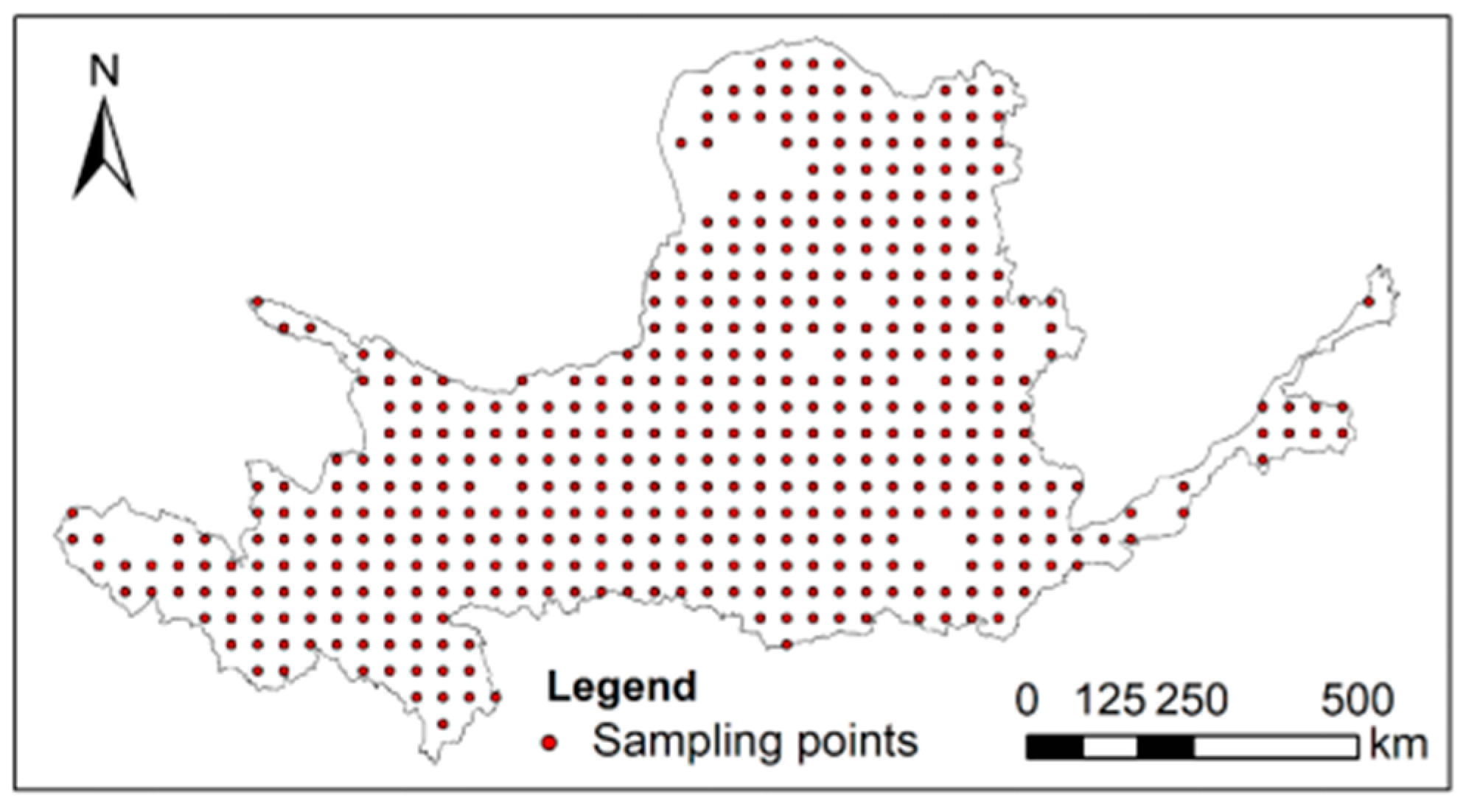

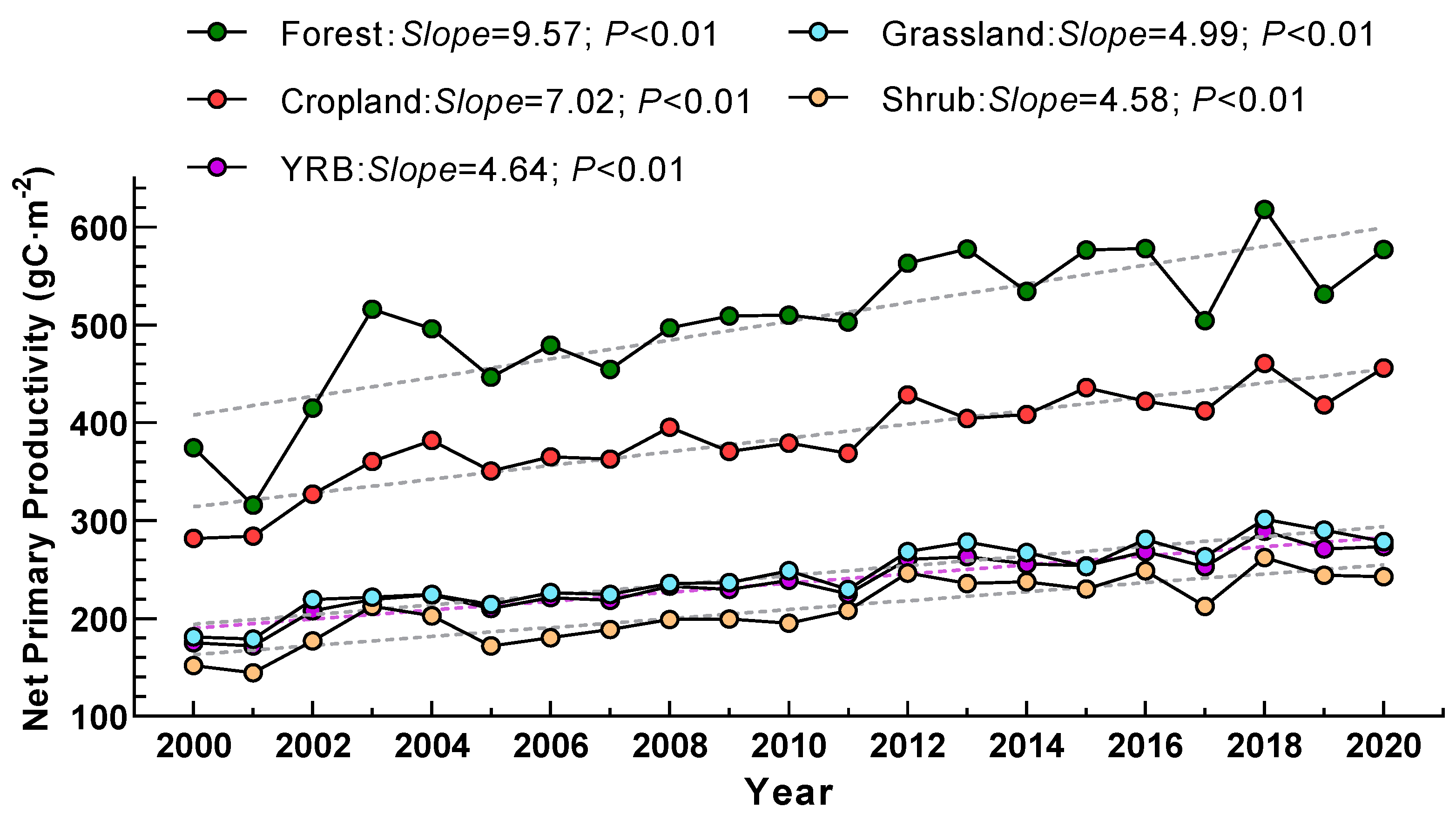
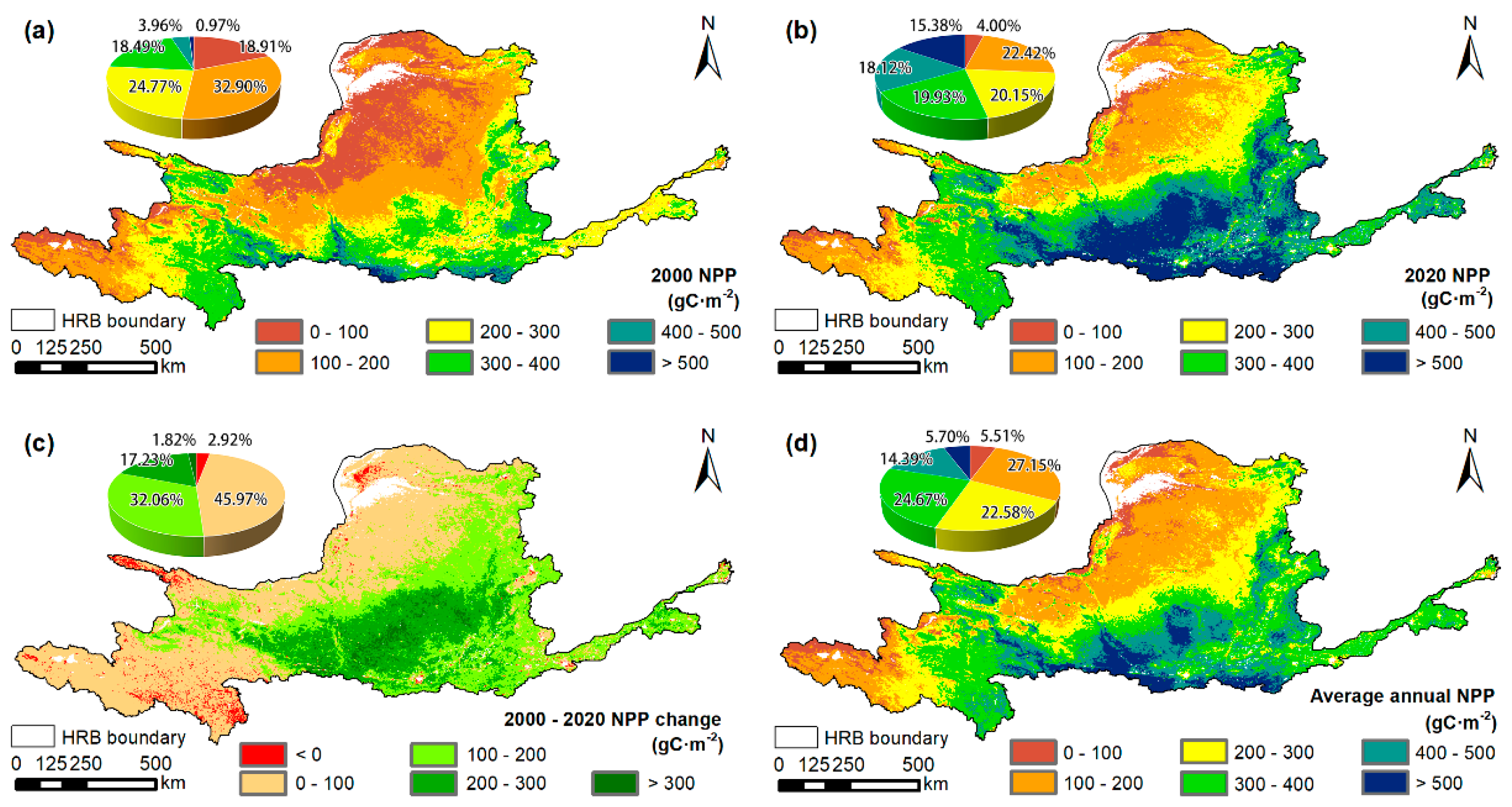
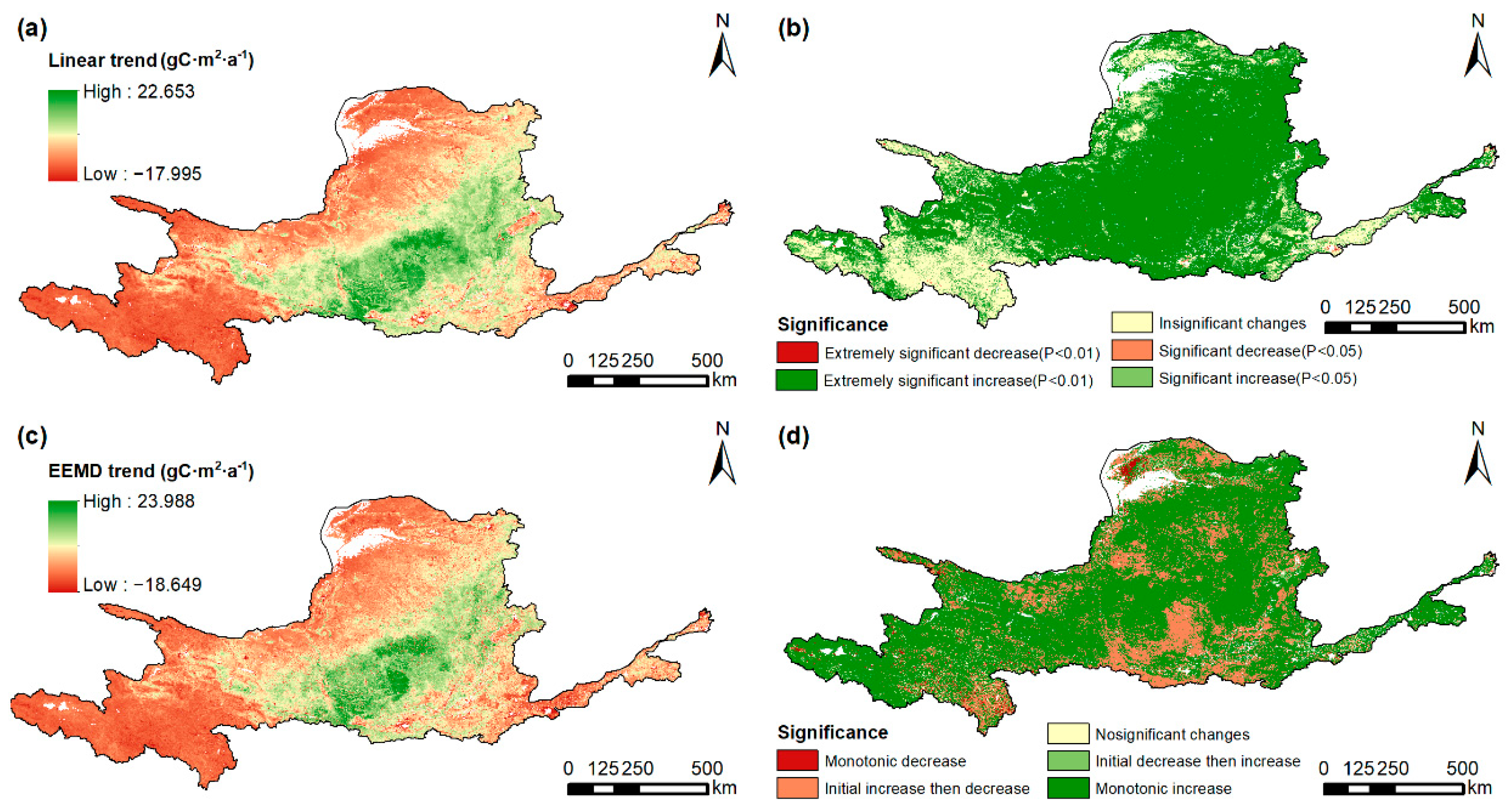
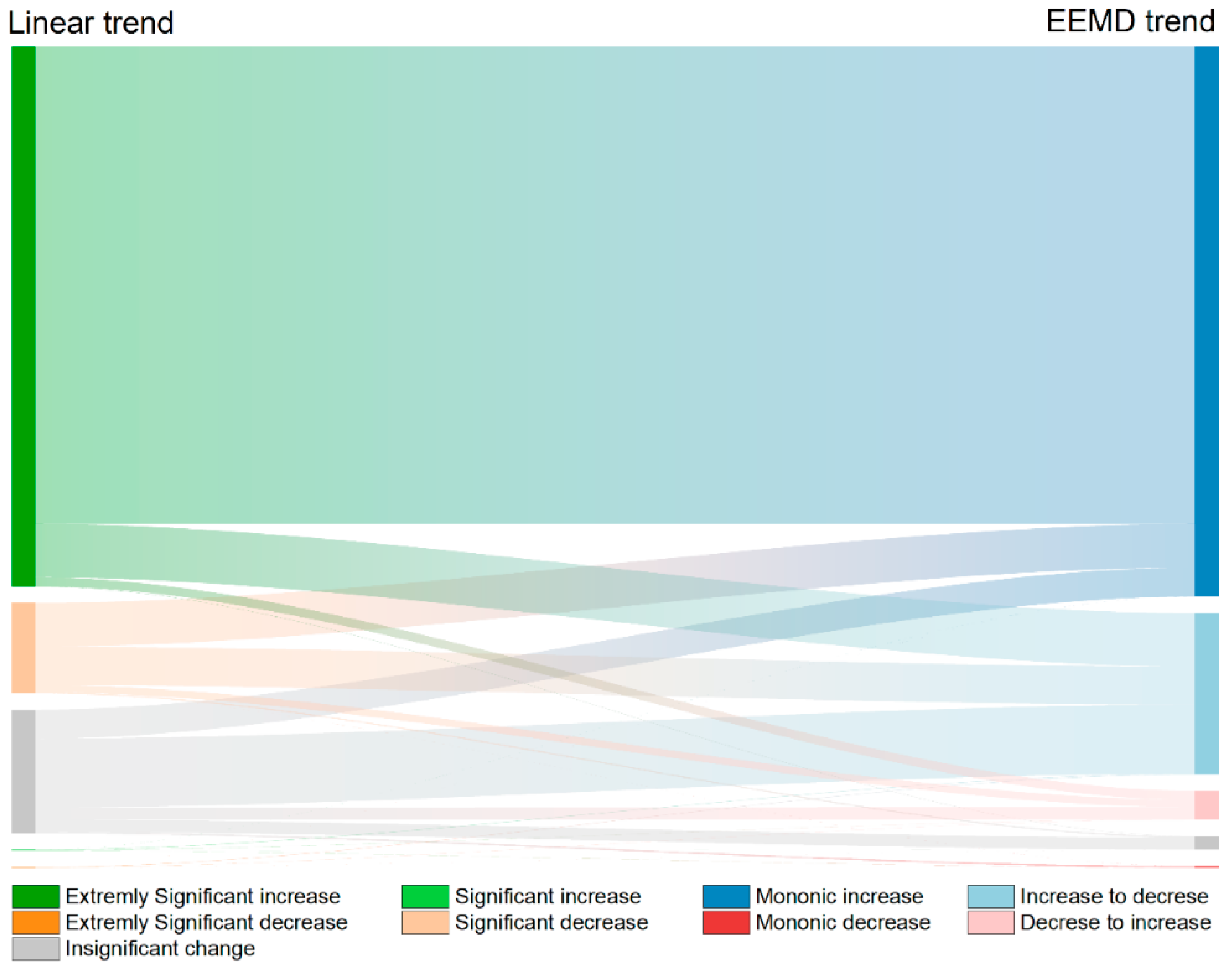

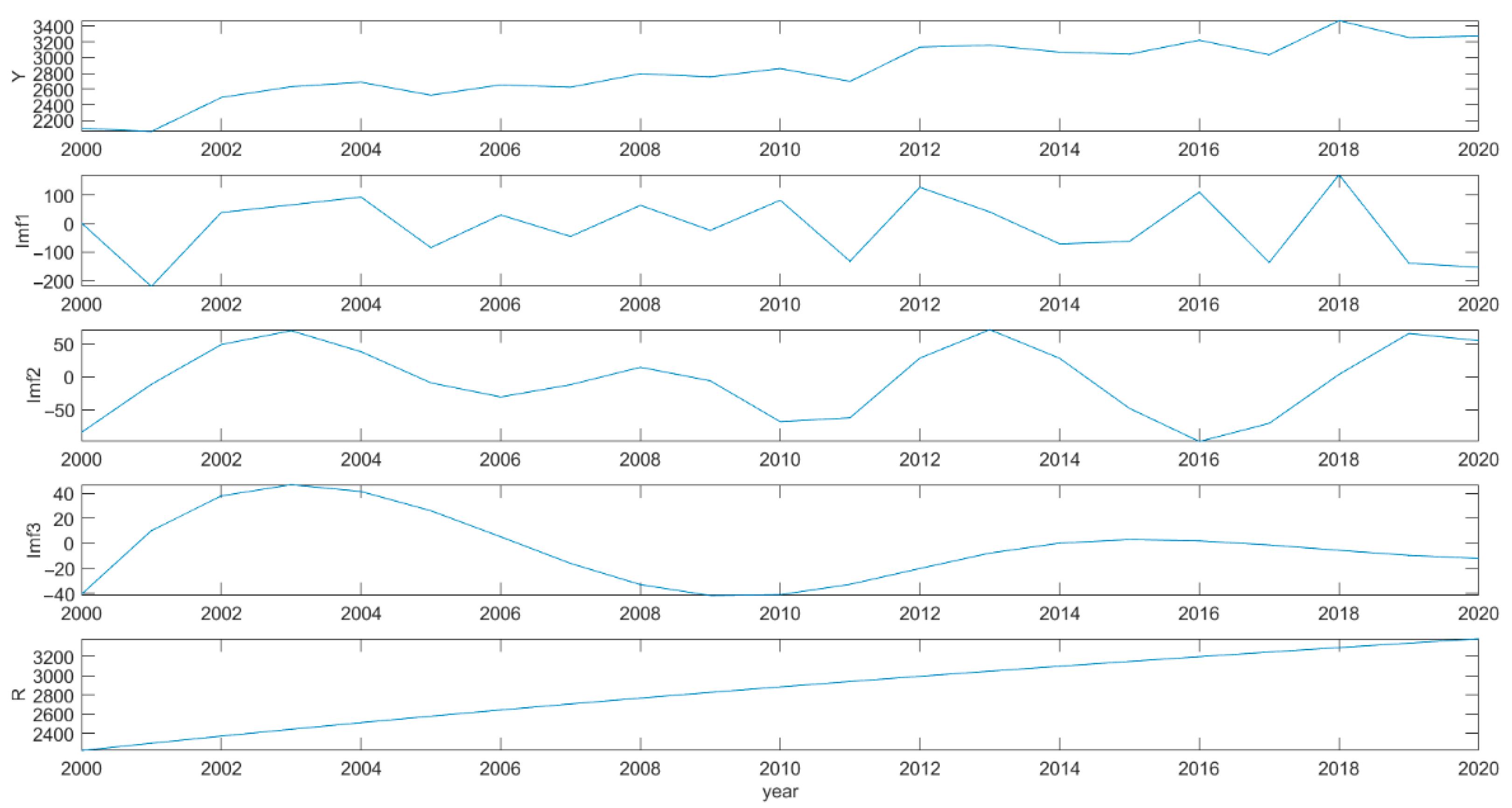
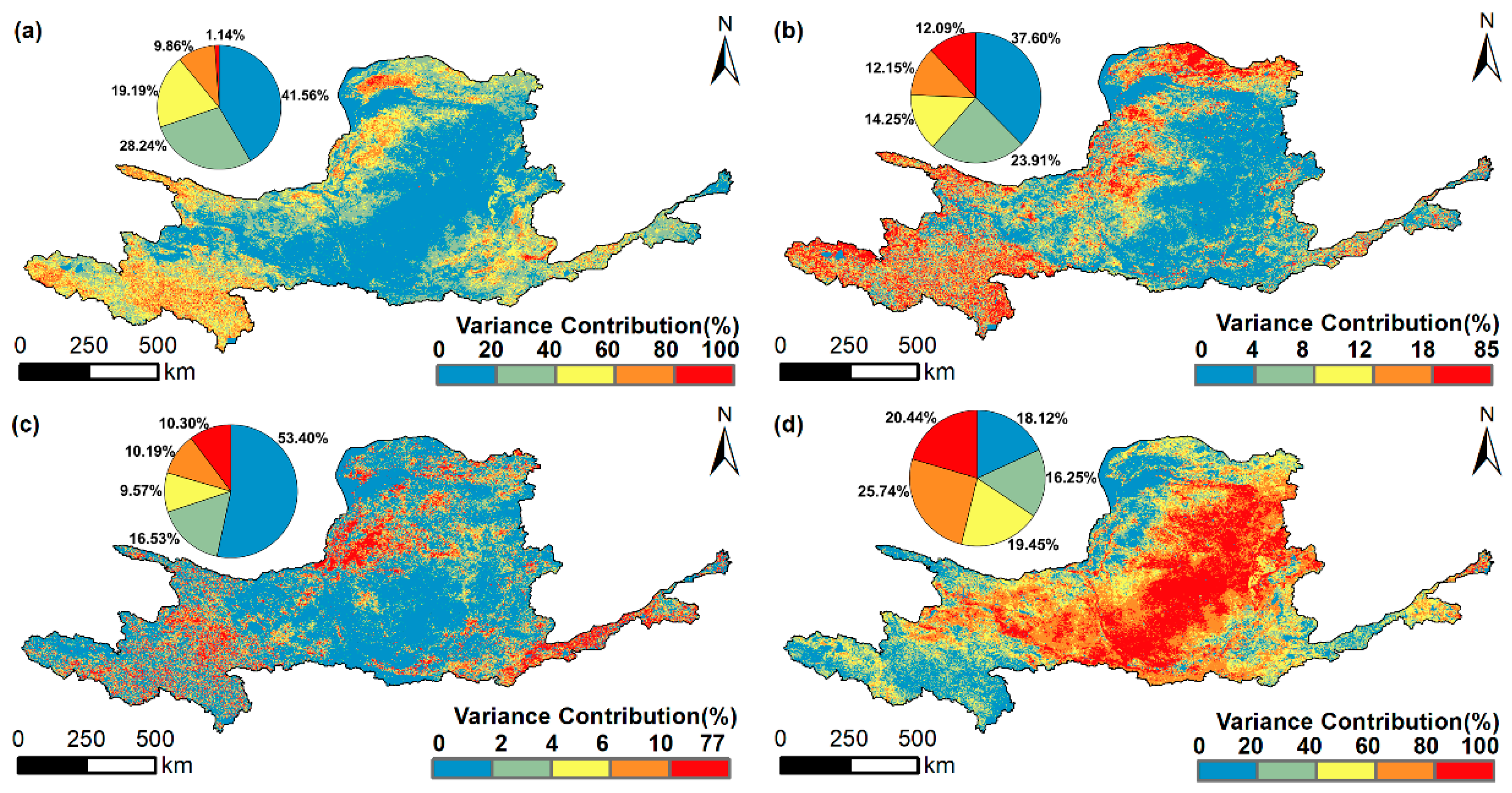
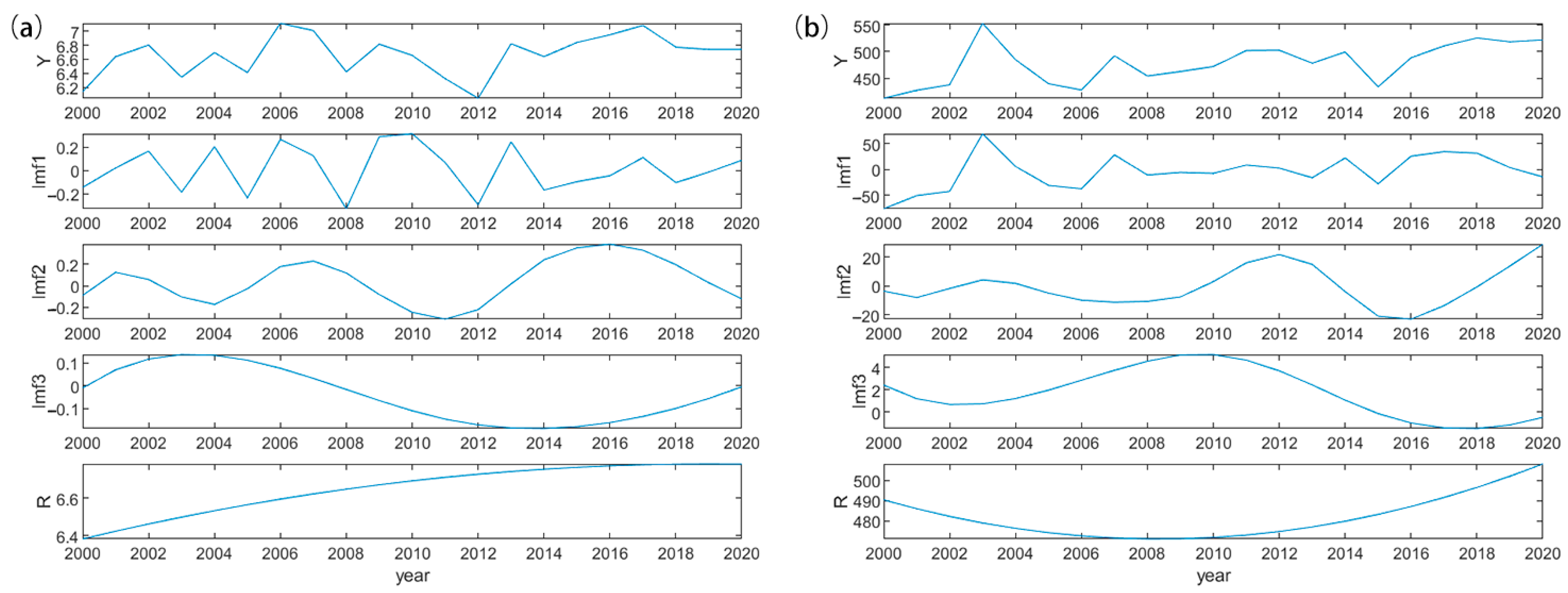
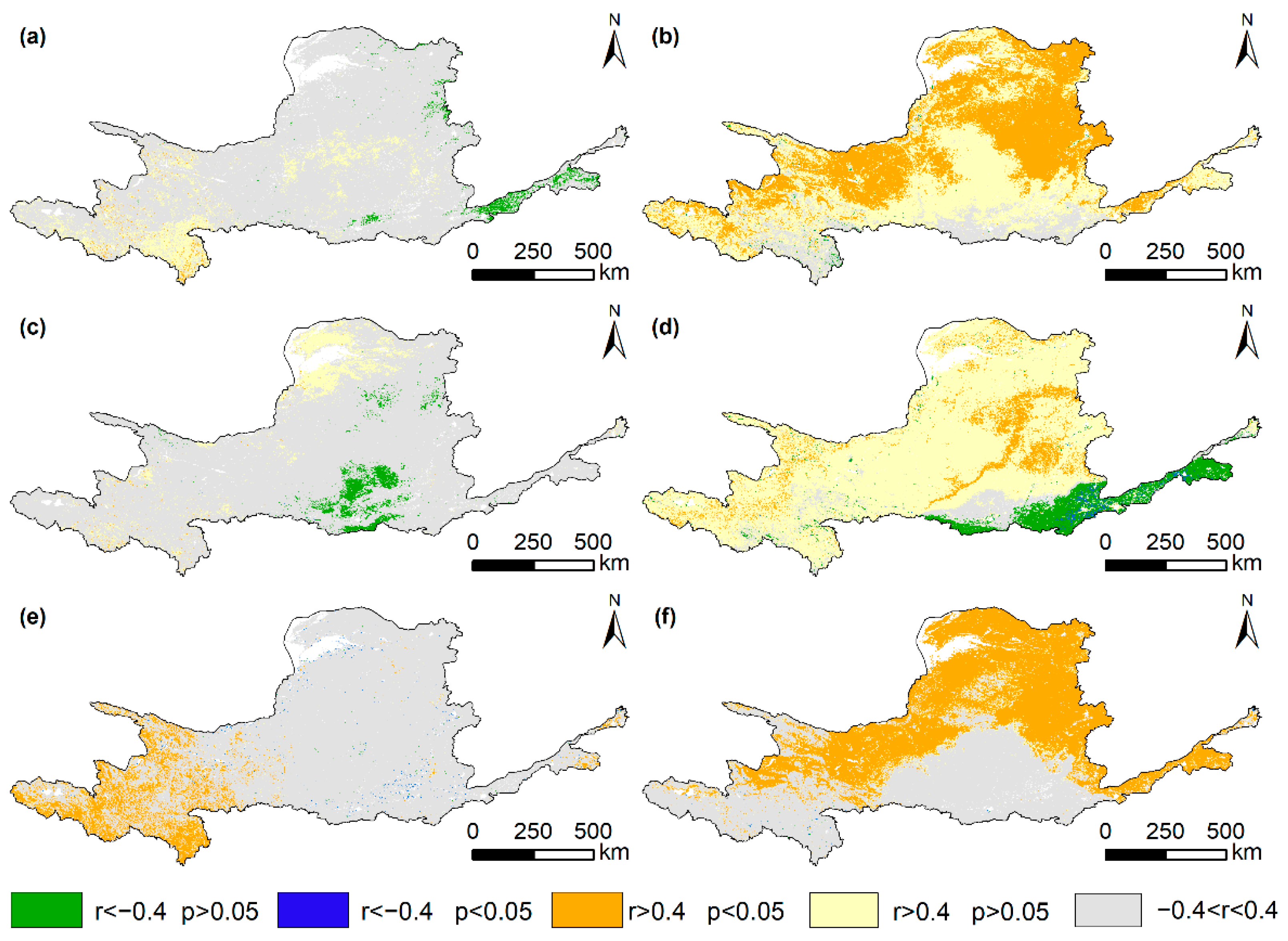



| Variables | Period | Original Spatial Resolution | Dataset | Data Source |
|---|---|---|---|---|
| NPP | 2000–2020 | Yearly/500 m | MOD17A3HGF | https://developers.google.com/earth-engine/datasets/catalog/MODIS_061_MOD17A3HGF (accessed on 6 January 2023) |
| DEM | 2018 | 30 m | https://www.gscloud.cn/ (accessed on 6 May 2023) | |
| Temperature | 2000–2020 | Monthly/1 km | China 1 km resolution monthly average temperature dataset | http://loess.geodata.cn (accessed on 18 January 2023) |
| Precipitation | 2000–2020 | Monthly/1 km | China 1 km resolution monthly average precipitation dataset | http://loess.geodata.cn (accessed on 18 January 2023) |
| Population density | 2000–2020 | 1 km | Gridded Population density of the World (GPW), Version 4 | https://cds.climate.copernicus.eu/ (accessed on 6 January 2023) |
| Night-time light | 2000–2020 | 500 m | https://doi.org/10.1038/s41597-020-0510-y (accessed on 6 January 2023) | |
| Land-use type | 2015 | 1 km | Land-use dataset in China (1980–2015) | http://www.resdc.cn/ (accessed on 6 January 2023) |
| Variable Types | IMF1 | IMF2 | IMF3 | Residue |
|---|---|---|---|---|
| Period (timescale/a) | 3 | 6 | 10.5 | — |
| Variance contribution (%) | 50.73 | 13.26 | 2.47 | 33.54 |
| Ranking | 1 | 3 | 4 | 2 |
| Grassland | Forest | Cropland | Shrublands | |
|---|---|---|---|---|
| IMF1 | 52.11 | 55.65 | 45.73 | 52.96 |
| IMF2 | 10.40 | 7.56 | 7.30 | 8.92 |
| Residue | 33.45 | 33.16 | 42.72 | 34.60 |
| IMF1 | IMF2 | IMF3 | Residue | ||
|---|---|---|---|---|---|
| Temperature | Period (timescale/a) | 3 | 6 | 20 | — |
| Variance contribution (%) | 35.37 | 32.31 | 13.90 | 17.43 | |
| Ranking | 1 | 2 | 4 | 3 | |
| Precipitation | Period (timescale/a) | 3 | 6 | 21 | — |
| Variance contribution (%) | 79.27 | 12.60 | 0.39 | 7.74 | |
| Ranking | 1 | 2 | 4 | 3 |
Disclaimer/Publisher’s Note: The statements, opinions and data contained in all publications are solely those of the individual author(s) and contributor(s) and not of MDPI and/or the editor(s). MDPI and/or the editor(s) disclaim responsibility for any injury to people or property resulting from any ideas, methods, instructions or products referred to in the content. |
© 2023 by the authors. Licensee MDPI, Basel, Switzerland. This article is an open access article distributed under the terms and conditions of the Creative Commons Attribution (CC BY) license (https://creativecommons.org/licenses/by/4.0/).
Share and Cite
Lin, Z.; Liu, Y.; Wen, Z.; Chen, X.; Han, P.; Zheng, C.; Yao, H.; Wang, Z.; Shi, H. Spatial–Temporal Variation Characteristics and Driving Factors of Net Primary Production in the Yellow River Basin over Multiple Time Scales. Remote Sens. 2023, 15, 5273. https://doi.org/10.3390/rs15225273
Lin Z, Liu Y, Wen Z, Chen X, Han P, Zheng C, Yao H, Wang Z, Shi H. Spatial–Temporal Variation Characteristics and Driving Factors of Net Primary Production in the Yellow River Basin over Multiple Time Scales. Remote Sensing. 2023; 15(22):5273. https://doi.org/10.3390/rs15225273
Chicago/Turabian StyleLin, Ziqi, Yangyang Liu, Zhongming Wen, Xu Chen, Peidong Han, Cheng Zheng, Hongbin Yao, Zijun Wang, and Haijing Shi. 2023. "Spatial–Temporal Variation Characteristics and Driving Factors of Net Primary Production in the Yellow River Basin over Multiple Time Scales" Remote Sensing 15, no. 22: 5273. https://doi.org/10.3390/rs15225273






